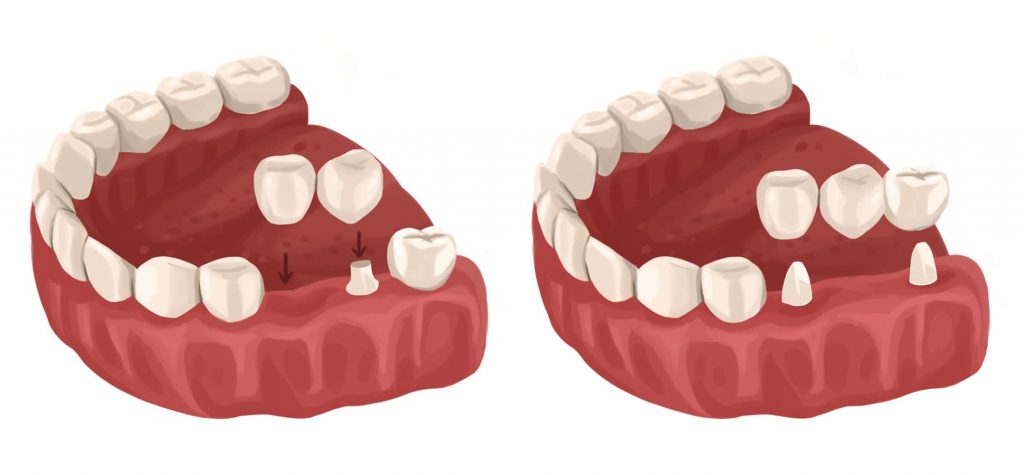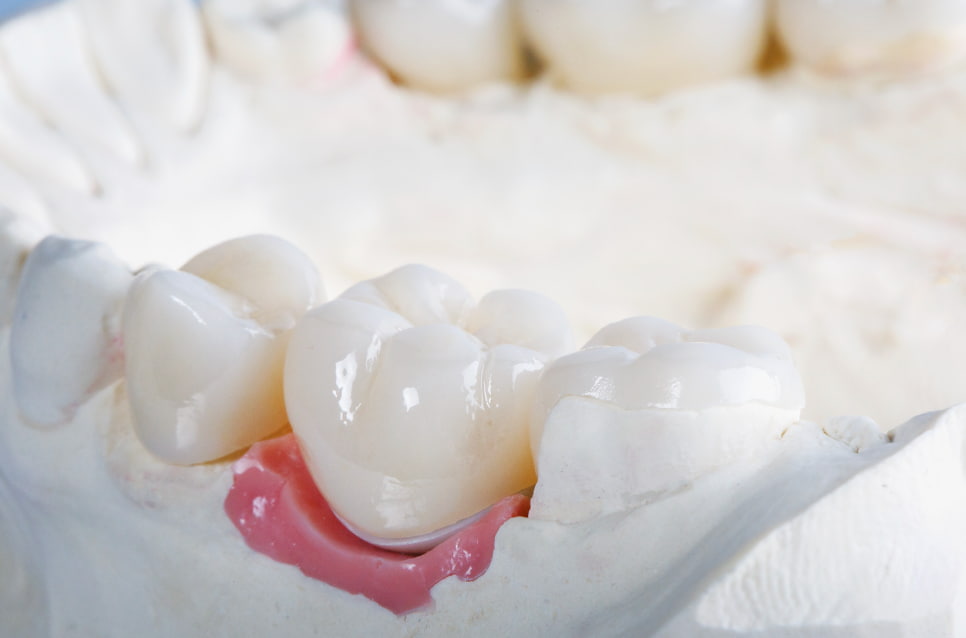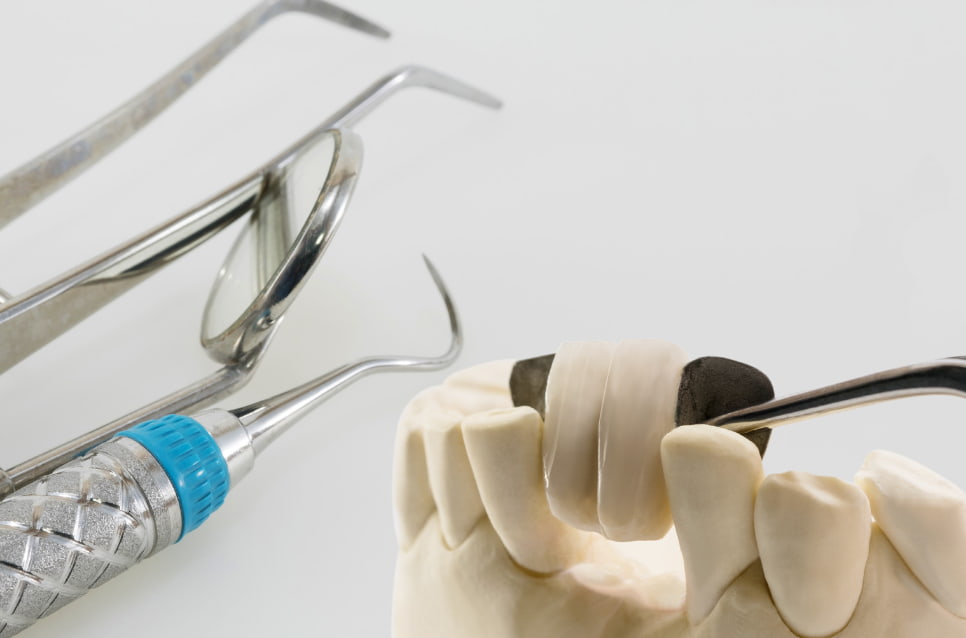A dental bridge is a type of restoration used to replace or fill a gap left by missing teeth. Depending on the construction of the bridge and what it’s anchored to, there are four different types of bridges: implant-supported bridge, traditional bridge (anchored to teeth on either side of the gap), Maryland bridge (anchored with metal wings instead of crowns) and, lastly, there’s the cantilever dental bridge.
A dental cantilever bridge is unique in that it supports the missing tooth only on one side. While on the one hand, it has the advantage of preserving more of the natural tooth structure, on the other, it can end up being less strong than a traditional bridge. Still, it can be a suitable option in certain instances. In this guide, you’ll learn more about how cantilever bridges work, how long they last, who is a good candidate, and how much they cost.
What Is A Dental Cantilever Bridge?
A cantilever bridge is a type of fixed dental prosthesis that’s anchored by one or more abutment teeth only on one side of a gap left behind by a missing tooth.
An abutment tooth refers to a healthy tooth which is shaved down so that a dental crown can be placed on top of it. It acts as an anchor, which is why it’s also known as an anchor tooth. On the other hand, the crown in the bridge that replaces the missing tooth is known as a pontic.

So, the main difference between a traditional and a cantilever bridge is that the former has an abutment on both sides of the gap, while the latter only has one side. It should, however, be noted that cantilever bridges might not necessarily have only one abutment tooth. There can be multiple, but they’ll all be on one side only.
However, according to a 2016 study published in the Journal of American Science, while multiple abutments might “limit the forces” on the abutment right next to the pontic, it has several drawbacks. One of them is that it ends up involving more teeth (so the treatment isn’t so preservative then). Additionally, it may have the potential to affect oral health.
Only your dentist can tell you what will best meet your needs, so make sure to thoroughly consult them about all the available options.
What Is The Procedure For Cantilever Dental Bridge?
Once you arrive at the clinic, your dentist might begin with the administration of local anaesthesia so that you don’t experience pain during the prepping or shaving of your abutment tooth.
After it has taken effect, they’ll use a dental handpiece to remove the enamel from the tooth. Following that, an impression of your teeth will be taken so that the lab, where your bridge will be prepared, has a model of your mouth. It will allow them to make a bridge that fits precisely and doesn’t have any bite issues.

However, the tooth prepping and impression taking will taken in one appointment, and you’ll have to wait till the next one for your cantilever bridge to be cemented in place. It can take one more appointment if there are any issues with the fit or bite of the bridge that has been prepared.
In the meantime, you’ll likely be fitted with a temporary bridge so you can retain some of the normal functioning of your teeth and have concerns regarding compromised aesthetics alleviated. After the permanent bridge comes, it will replace the temporary one.
How Long Does A Cantilever Dental Bridge Last?
A cantilever dental bridge may last you for more than a decade. A 2010 study published in the Journal of Evidence-Based Dental Practice reported an 81.8% success rate of cantilever prostheses after 10 years.
Another study published in the Japanese Dental Science Review also concluded that resin-bonded fixed cantilever prostheses had “excellent long-term clinical outcomes,” and they might be especially suited for the incisors.
However, here, it’s important to emphasise the importance of good oral health care as well for the longevity of cantilever bridges. Even if they’re not your natural teeth, you need to brush twice a day for at least two minutes. Flossing is also important, as well as getting regular dental check-ups.
Who Is Suitable For A Dental Cantilever Bridge?
You might be considered a suitable candidate for dental cantilever bridge if:
- You are missing front teeth – as a cantilever bridge is not too strong and back teeth are more involved in the chewing of the food, they might break more easily there.
- You have only one natural tooth for anchorage – If you only have one tooth next to the missing gap, or the tooth on the other side is not too strong, a cantilever bridge might work better.
- You have a healthy mouth – It’s also important that you have healthy gum tissue and a good bite for a cantilever bridge. If your teeth are too weak from wear, for instance, it won’t make a strong enough abutment.
Another point noted in a 2012 review published in ISRN Dentistry is that the failure of a cantilever bridge is more common when the tooth is not vital (dead tooth). So, your dentist might check for that as well through thermal or electrical stimulation.

This kind of bridge can have several advantages in that it can restore the aesthetics and proper functioning of your teeth. It might also improve articulation in speech. Moreover, it may prevent the surrounding teeth from shifting into the empty space left behind by the missing tooth.
How Much Is A Dental Cantilever Bridge In The UK?
Dental bridge is a Band 3 dental treatment on the NHS, which is available for £306,80. However, only your dentist will be able to tell you whether or not it’s specifically a cantilever bridge that you’ll be getting.
If you’re getting a cantilever bridge privately, a single unit might cost you anywhere from £300 to £1,000. It can depend on the type of material that’s being used. You might be able to get a cantilever bridge in porcelain, porcelain fused to metal, zirconia, gold, etc.
If you’re looking for a more affordable option, you can consider dental tourism in Turkey, where a single unit of crown may start from £200.
The overall price, however, will be affected by the total number of units within the bridge for the abutment and the pontics, as well as the complexity of the treatment. The location of the clinic and the experience and qualification of your dentist can also affect the cost.
Conclusion
A cantilever dental bridge can be useful in bridging the gap left behind by a missing tooth, but keep in mind that it has certain limitations. And it’s mainly because of the bridge being anchored on only one side and not the other.
If you have been contemplating getting this type of bridge, it’s important that you first get yourself checked by a medical professional and discuss your goals and needs with them. They’ll then help prepare the most suitable treatment plan for you.
Reviewed and approved by Dr Izbel Aksit
FAQ
How many teeth can a cantilever bridge replace?
Usually, a cantilever bridge is used to replace one missing tooth. Additional pontics, however, might be risky, but only your dentist can best guide you on this.
Are cantilever dental bridges strong?
Cantilever bridges are said to be relatively less strong than traditional bridges because they’re only supported on one end and not the other.
How does a cantilever dental bridge work?
A 2-unit cantilever bridge works by getting anchored to an abutment tooth on one side of the gap left behind by a missing tooth. One dental crown goes over the shaved-down natural tooth, and the other fills the gap.
When is a dental cantilever bridge not recommended?
A dental cantilever bridge might not be recommended if you don’t have a vital tooth, healthy gum tissue, strong teeth or a good bite, but this is something that you must further consult your dentist about.
